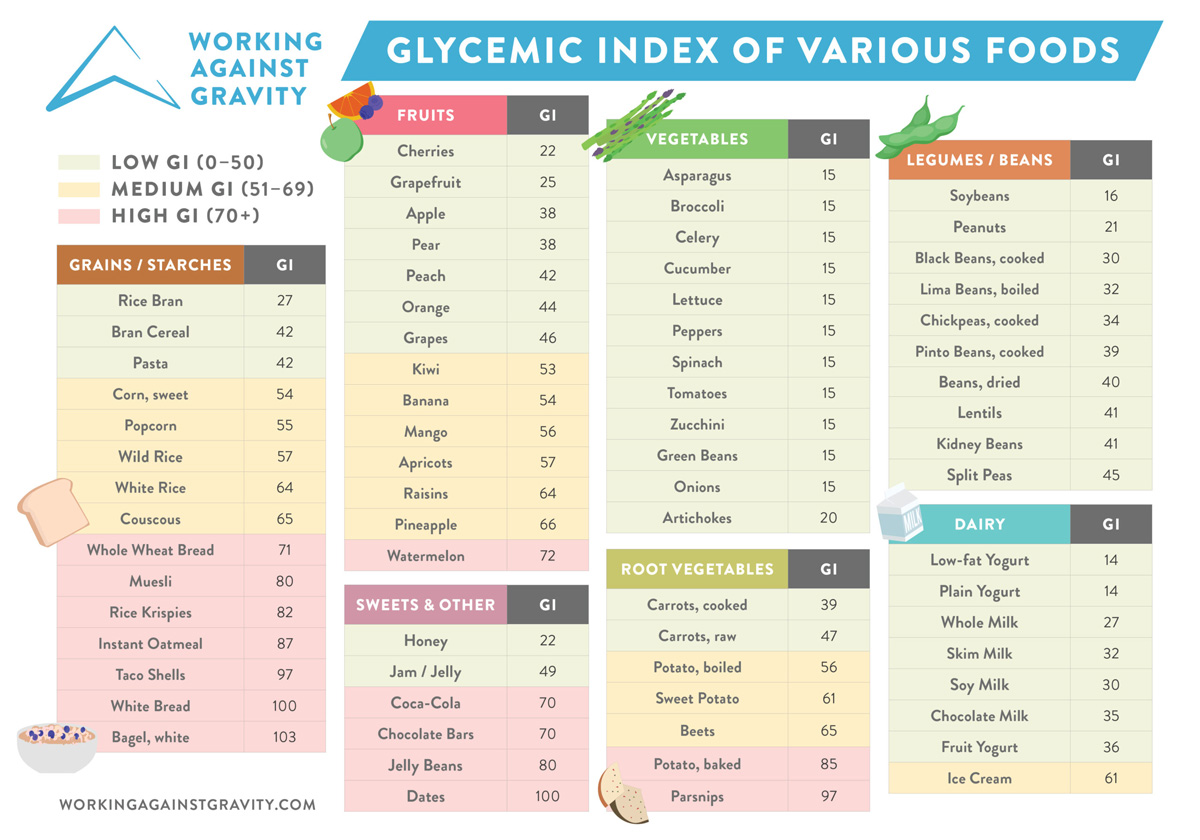What is the glycemic index (GI)?

A bowl of chickpeas has the same amount of carbohydrates as a handful of jelly babies, but they have very different effects on blood sugar levels. This is what the GI quantifies.
It’s a classification of foods containing carbs that ranks them by the effect they have on blood sugar levels on a scale of 0 to 100, where the higher the GI of the food, the more it raises blood sugar levels [i]https://glycemicindex.com/about-gi/#:~:text=What%20is%20the,is%20the%20evidence..
How is GI measured?

GI of a food is calculated by feeding a group of healthy people a portion of that food containing 50 grams of digestible carbohydrate and measuring their blood glucose response. This is compared against their blood sugar response to 50 grams of the reference food which is pure glucose (the most simple sugar) [ii]https://glycemicindex.com/about-gi/#:~:text=Following%20the%C2%A0international,its%20GI%20value..
What are the benefits of eating low GI?
- Less blood sugar fluctuations make T1D easier to manage.
- Reduces total and LDL cholesterol levels [iii]https://pubmed.ncbi.nlm.nih.gov/22841185/
- Helps with weight management since lower levels of insulin and blood sugar suppress hunger signals [iv]https://pubmed.ncbi.nlm.nih.gov/21105792/
What are the issues with GI?
- While many healthy foods are high GI, they are low in carbohydrates per serving, so will actually have a low impact on blood sugars. For example – watermelon has a GI of 72, but only has 7 grams of carb per 100 grams. Glycemic load combines carbohydrate quantity with GI to give a better predictor of metabolic effect.
- On the other hand, many unhealthy high fat foods have a low GI
- GI doesn’t consider dietary effect on insulin resistance. Some low GI foods can cause insulin resistance that may cause greater glycemic excursions than high GI, low resistance foods.
- The GI of foods changes when eaten with other foods as part of a meal.
- GI is calculated from the average of a groups blood glucose response, and personal responses may not correlate. For example: porridge oats are widely hailed as low GI but personally cause huge sugar spikes.
What factors determine GI?
What it comes down to is how quickly the carbs are digested, absorbed and metabolised. I think understanding the factors that determine this is more useful than looking at GI charts.
- Type of carbohydrate – not all carbohydrates are created equal! They all have different structures, some simple others complex, and it’s this structure that determines how quickly they can be broken down into glucose – the form in which they’re absorbed into the blood.
Ripening of fruit breaks complex sugars into simple ones, increasing GI. Cooking food increases GI but different cooking methods have different effects. Interestingly, various physical factors like stirring, water-starch ratio, and cooking and cooling regimes affect resistant starch formation.
For example – upon cooling, some of the gelatinized digestible starches in pasta, potatoes and other starchy foods are converted into resistant starches through the process of retrogradation, reducing GI. [v]https://www.ncbi.nlm.nih.gov/pmc/articles/PMC4994556/
- Surface area – an orange will spike sugars far more if blended into a juice than if simply eaten because liquid carbs are absorbed so much faster. For this reason, processing increases rate of digestion.
- Physical entrapment of the starch molecules within the food
- Protein content – protein can slow gastric emptying ( the time it takes for food to leave the stomach and enter the intestine) but can break down into carbohydrates, raising blood sugar levels [vii] … Continue reading
- Fat content – fat also slows gastric emptying but also increases insulin resistance [viii]https://pubmed.ncbi.nlm.nih.gov/25441706/. This causes a delayed rise in blood sugars and a lag in time to peak blood glucose. [ix]https://diabetesjournals.org/care/article/38/6/1008/37384/Impact-of-Fat-Protein-and-Glycemic-Index-on
- Fibre content -soluble fibre is plant material that our digestive system can’t break down, which forms a jelly-like solution in the small intestine slowing gastric emptying [x]https://www.ncbi.nlm.nih.gov/pmc/articles/PMC3257631/
- Acidity – acidic foods slow gastric emptying.
References


Leave a Reply